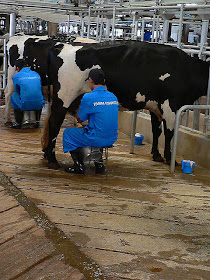To continue from the "Gotta be a pony in here somewhere"... I'm starting to make some vitamin tinctures from the weeds in my garden.
Above are the things I picked early this morning (June 16th, which is just 1 day past the full moon) to make some vitamin tinctures. Around the full moon is said to be the best time to harvest herbs for medicinal use. I don't know if that also applies to culinary use, but it might. That doesn't stop me from cutting fresh culinary herbs from the garden when I need them for a dish I'm preparing, but it might affect those same herbs when I want to dry some for winter.
The large stainless steel strainer basket is full of red raspberry leaves that I will dry for raspberry leaf tea. Raspberry leaf tea is not a tasty tea like mint tea; it's uses are more medicinal and you can do an internet search about them. Raspberry leaf tea was recommended by Dr. Abravanel as the morning beverage for the Thyroid Food Protocol which I followed many years ago. (Dr. Abravanel's Body Type Diet and Lifetime Nutrition Plan)
The small strainer basket in the top photo above has red clover, and the plastic bucket behind it has dandelion leaves. Many of the recipes for red clover used medicinally call for just the blossoms, but as I'm steeping mine for a vitamin tincture, I'll use some of the top (softer) stems and leaves as well as the blossoms. Red Clover contains calcium, iron, magnesium, manganese, phosphorus, potassium, selenium, and zinc as well as vitamins B3, C and E.
Medicinally, red clover has been called the "woman's herb" as it contains phytoestrogens, similar to estrogen, and is widely used during menopause. "Although the phytoestrogen effects of soy and flaxseed have been more widely studied, red clover may actually be a more effective treatment for relief of menopausal symptoms. It is an active ingredient in Promensil, an over-the-counter supplement used to help treat hot flashes." (Source) Red Clover has many herbal uses, but as I am not an Herbalist, I shan't go into that here.
Dandelion is rich in calcium, iron, magnesium, manganese, phosphorus, potassium, copper and zinc. It also contains vitamins K, B1 (thiamine), B2 (riboflavin), B3 (niacin) and C along with beta-carotene, which our bodies turn into vitamin A. I haven't been able to find a breakdown of nutritional content of roots, and I'm not up to digging roots right now. Instead I'll make a vitamin tincture from the leaves now, store it, and later mix it with a vitamin tincture made from the roots to get the whole vitamin/mineral chorus in dandelions. Below are the vitamin and mineral contents in 1 cup of chopped raw dandelion greens.
 |
| http://nutritiondata.self.com/facts/vegetables-and-vegetable-products/2441/2 |
To make a tincture requires only a base liquid, and the herbs or whatever you want to incorporate. Generally a food-grade alcohol like vodka, brandy, rum or Everclear is the liquid of choice, but I'm going to use raw apple cider vinegar for some added nutritional properties.
Note: Everclear generally needs water added because some nutritional properties of herbs are only water soluble, and Everclear has very little water; it is almost all food-grade alcohol, 190 proof, or 95% alcohol.
 |
| Dandelion leaves in vinegar |
To make the tincture: clean and rinse the leaves and stalks thoroughly as soon as possible after harvesting. (Vitamin loss starts immediately from any harvested fruit, vegetable or herb.)
 |
| Chopped red clover |
Drain and chop the plant material, enough to nearly fill a glass jar with a tight lid. Fully cover the leaves and stems with either the alcoholic beverage, or my choice: apple cider vinegar. (You could also use vegetable glycerin. Glycerin might be a good choice if making a tincture to give children since it has a sweet taste.) Tighten the lid securely (I'm using the plastic Ball storage lids because the acid content of the vinegar will eat through regular canning lids in a short time.) Store the jar(s) in a cool, dark place for at least 2 weeks although 6 weeks is better, shaking often. Then strain the infusion into clean jars, re-label and store... again in a cool, dark place.
If you think about it, flavored vinegars such as tarragon vinegar, or Provençal vinegar are nothing more than tinctures with a vinegar base, and so easy to make at home with fresh herbs! Since I take a spoonful or two of raw apple cider vinegar (ACV) every day anyway, it is easy instead to use ACV infused with extra vitamins and minerals as a healthy tonic.








































